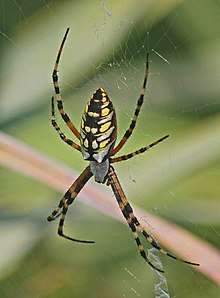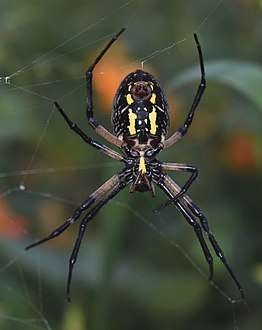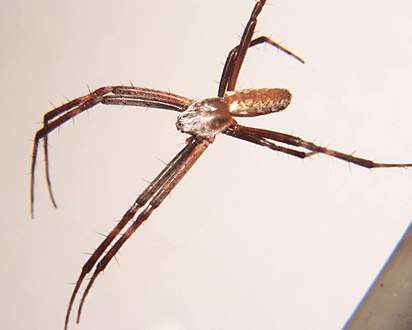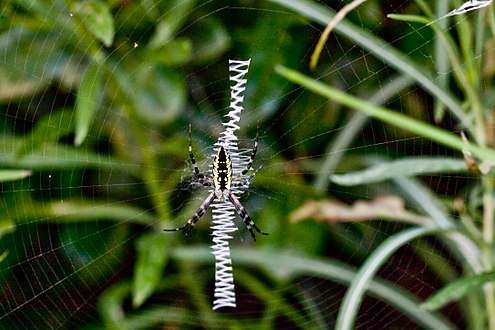Argiope aurantia
The spider species Argiope aurantia is commonly known as the yellow garden spider,[2][3] black and yellow garden spider,[4] golden garden spider,[5] writing spider, zigzag spider, hay spider, corn spider, or McKinley spider.[6] The species was first described by Hippolyte Lucas in 1833. It is common to the contiguous United States, Hawaii, southern Canada, Mexico, and Central America. It has distinctive yellow and black markings on the abdomen and a mostly white cephalothorax. Its scientific Latin name translates to "gilded silver-face" (the genus name Argiope meaning "silver-face", while the specific epithet aurantia means "gilded"). Males range from 5–9 mm (0.20–0.35 in); females range from 19–28 mm (0.75–1.10 in). These spiders may bite if disturbed or harassed, but the venom is harmless to non-allergic humans, roughly equivalent to a bumblebee sting in intensity.[7]
| Yellow garden spider | |
|---|---|
 | |
| Scientific classification | |
| Kingdom: | Animalia |
| Phylum: | Arthropoda |
| Subphylum: | Chelicerata |
| Class: | Arachnida |
| Order: | Araneae |
| Infraorder: | Araneomorphae |
| Family: | Araneidae |
| Genus: | Argiope |
| Species: | A. aurantia |
| Binomial name | |
| Argiope aurantia | |
| Synonyms | |
|
Nephila vestita | |
Habitat
Yellow garden spiders often build webs in areas adjacent to open sunny fields where they stay concealed and protected from the wind. The spider can also be found along the eaves of houses and outbuildings or in any tall vegetation where they can securely stretch a web.
Female Argiope aurantia spiders tend to be somewhat local, often staying in one place throughout much of their lifetime.
The web of the yellow garden spider is distinctive: a circular shape up to 2 feet (60 cm) in diameter, with a dense zigzag of silk, known as a stabilimentum, in the center. The purpose of the stabilimentum is disputed. It is possible that it acts as camouflage for the spider lurking in the web's center, but it may also attract insect prey, or even warn birds of the presence of the otherwise difficult-to-see web. Only those spiders that are active during the day construct stabilimenta in their webs.
To construct the web, several radial lines are stretched among four or five anchor points that can be more than three feet apart. The radial lines meet at a central point. The spider makes a frame with several more radial lines and then fills the center with a spiral of silk, leaving a 5⁄16-to-3⁄8-inch (7.9 to 9.5 mm) gap between the spiral rings, starting with the innermost ring and moving outward in a clockwise motion. To ensure that the web is taut, the spider bends the radial lines slightly together while applying the silk spiral. The female builds a substantially larger web than the male's small zigzag web, often found nearby. The spider occupies the center of the web, usually facing straight down, waiting for prey to become ensnared in it. If disturbed by a possible predator, she may drop from the web and hide on the ground nearby. The web normally remains in one location for the entire summer, but spiders can change locations usually early in the season, perhaps to find better protection or better hunting.
The yellow garden spider can oscillate her web vigorously while she remains firmly attached in the center.[8] This action might prevent predators like wasps and birds from drawing a good bead, and also to fully entangle an insect before it cuts itself loose. However, in a case observed in Georgia, Davis witnessed a Vespa crabro fly into the spider's web and get tangled up. Upon looking closer it was found that V. crabro was actually cutting free prey that had been caught in the A. aurantia web. In this case, A. aurantia did not interfere or fight with the European hornet, probably because it dropped from the web and hid nearby.[9]
In a nightly ritual, the spider consumes the circular interior part of the web and then rebuilds it each morning with fresh new silk. The radial framework and anchoring lines are not usually replaced when the spider rebuilds the web. The spider may be recycling the chemicals used in web building. Additionally, the fine threads that she consumes appear to have tiny particles of what may be minuscule insects and organic matter that may contain nutrition.[10]
The yellow garden spider does not live in very dense location clusters like other orb spiders such as the golden orb web spider. The yellow garden spider keeps a clean orderly web in comparison to the cluttered series of webs built and abandoned by groups of golden orb spiders.
Distribution
This spider is found from Canada to Costa Rica,[1] but less so in the basin and mountain areas of the Rockies.[11]
Venom
Argiope spiders are not aggressive. They might bite if grabbed, but other than for defense they do not attack large animals. Their venom often contains a library of polyamine toxins with potential as therapeutic medicinal agents. Notable among these is the argiotoxin ArgTX-636.[12]
A bite by Argiope aurantia is comparable to a bee sting with redness and swelling. For a healthy adult, a bite is not considered an issue. Though they are not aggressive spiders, the very young, elderly, and those with compromised immune systems should exercise caution, just as they would around a beehive or a hornet nest.[13][14][15]
Reproduction
Yellow garden spiders breed twice a year. The males roam in search of a female, building a small web near or actually in the female's web, then court the females by plucking strands on her web. Often, when the male approaches the female, he has a safety drop line ready, in case she attacks him. The male uses the palpal bulbs on his pedipalps to transfer sperm to the female. After inserting the second palpal bulb, the male dies, and is sometimes then eaten by the female.[16]
The female lays her eggs at night on a sheet of silky material, then covers them with another layer of silk, then a protective brownish silk. She then uses her legs to form the sheet into a ball with an upturned neck. Egg sacs range from 5/8" to 1" in diameter. She often suspends the egg sac right on her web, near the center where she spends most of her time. Each spider produces from one to four sacs with perhaps over a thousand eggs inside each. She guards the eggs against predation as long as she is able. However, as the weather cools, she becomes more frail, and dies around the time of the first hard frost.[7]
In the spring, the young spiders exit the sac. They are so tiny that they look like dust gathered inside the silk mesh. Some of the spiderlings remain nearby, but others exude a strand of silk that gets caught by the breeze, carrying the spiderling to a more distant area.[7]
Eating habits
Females of the species are the most commonly seen in gardens. Their webs are usually characterized by a zigzag shaped stabilimentum (an extra thick line of silk) in the middle extending vertically. The spiders spend most of their time in their webs, waiting for prey to become ensnared. When prey becomes caught in the web, the spider may undulate the web back and forth to further trap the insect. When the prey is secure, the spider kills it by injecting its venom and then wraps the prey in a cocoon of silk for later consumption (typically 1–4 hours later). Prey includes small vertebrates, such as geckos and green anoles, as well as insects.[7][17]
Gallery
 Female
Female Ventral view
Ventral view Side view
Side view Male
Male In web, displaying the characteristic zig-zag stabilimentum
In web, displaying the characteristic zig-zag stabilimentum_in_its_web.jpg)
 Egg sac
Egg sac Eating a swallowtail butterfly in Holly Springs, North Carolina
Eating a swallowtail butterfly in Holly Springs, North Carolina Female consuming a moth
Female consuming a moth
References
- "Taxon details Argiope aurantia Lucas, 1833", World Spider Catalog, Natural History Museum Bern, retrieved 2020-07-27
- Pictures of yellow garden spider A. aurantia (free for noncommercial use)
- Weber, Larry (2003). Spiders of the North Woods. Duluth, MN: Kollath-Stensons. pp. 76–77.
- Black and Yellow Garden Spider - Argiope aurantia Creative Commons Licensed
- Eaton, E. R. & K. Kaufman (2007). Kaufman Field Guide to Insects of North America. New York: Houghton Mifflin. p. 22.
- Rotary International (July 1951). The Rotarian. Rotary International. pp. 41–. ISSN 0035-838X.
- Hammond, George. "Argiope aurantia at the University of Michigan's Animal Diversity Web". Archived from the original on 11 July 2007. Retrieved 2007-07-30.
- Garden Spider Oscillating Web - Video
- Davis, M. (2011). "A Hornet (Vespa crabro) Steals Prey from a Spider (Argiope aurantia)". Southeastern Naturalist. 10 (1): 191–192. doi:10.1656/058.010.0119.
- Streed, Janelle L. (August 30, 2012). "Black and Yellow Garden Spider, Writing Spider, or Corn Spider Argiope aurantia". Project Noah. Networked Organisms. Archived from the original on August 21, 2017. Retrieved August 21, 2017.
- Ely, Charlotte (2003). "The Biogeography of the Writing Spider (Argiope aurantia)". San Francisco State University. Retrieved 26 July 2020.
- Nentwig, Wolfgang (2013-02-15). Spider Ecophysiology. Springer Science & Business Media. ISBN 9783642339899.
- Hawkinson, Candice. "Beneficials in the Garden: Black-and-Yellow Argiope Spider". Texas A&M University. Retrieved 29 September 2014.
- "Garden Spiders: Facts, Identification & Control". orkin.com. Retrieved 2019-11-16.
- Spencer, Jill (2018-10-29). "The Yellow Garden Spider (Argiope Aurantia)". owlcation.com. Retrieved 2019-11-16.
- Hickey, Georgina; Lee, Michael (2004). "Loved to Death". Nature Australia. 12: 11–13.
- Gorham, J. Richard (25 November 1968). "Envenomation by the Spiders Chiracanthium inclusum and Argiope aurantia". JAMA. 206 (9): 1958. doi:10.1001/jama.1968.03150090034007.
External links
- "Argiope aurantia" at the Encyclopedia of Life

- Garden Spider Web video CC Licensed
- Garden Spider Posture During Rain - Video
| Wikimedia Commons has media related to Argiope aurantia. |